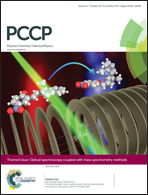Probing the molecular structures of plasma-damaged and surface-repaired low-k dielectrics†
Abstract
Fully understanding the effect and the molecular mechanisms of plasma damage and silylation repair on low dielectric constant (low-k) materials is essential to the design of low-k dielectrics with defined properties and the integration of low-k dielectrics into advanced interconnects of modern electronics. Here, analytical techniques including sum frequency generation vibrational spectroscopy (SFG), Fourier transform infrared spectroscopy (FTIR), contact angle goniometry (CA) and X-ray photoelectron spectroscopy (XPS) have been employed to provide a comprehensive characterization of the surface and bulk structure changes of poly(methyl)silsesquioxane (PMSQ) low-k thin films before and after O2 plasma treatment and silylation repair. O2 plasma treatment altered drastically both the molecular structures and water structures at the surfaces of the PMSQ film while no bulk structural change was detected. For example, ∼34% Si–CH3 groups were removed from the PMSQ surface, and the Si–CH3 groups at the film surface tilted toward the surface after the O2 plasma treatment. The oxidation by the O2 plasma made the PMSQ film surface more hydrophilic and thus enhanced the water adsorption at the film surface. Both strongly and weakly hydrogen bonded water were detected at the plasma-damaged film surface during exposure to water with the former being the dominate component. It is postulated that this enhancement of both chemisorbed and physisorbed water after the O2 plasma treatment leads to the degradation of low-k properties and reliability. The degradation of the PMSQ low-k film can be recovered by repairing the plasma-damaged surface using a silylation reaction. The silylation method, however, cannot fully recover the plasma induced damage at the PMSQ film surface as evidenced by the existence of hydrophilic groups, including C–O/C![[double bond, length as m-dash]](https://www.rsc.org/images/entities/char_e001.gif) O and residual Si–OH groups. This work provides a molecular level picture on the surface structural changes of low-k materials after plasma treatment and the subsequent silylation repair.
O and residual Si–OH groups. This work provides a molecular level picture on the surface structural changes of low-k materials after plasma treatment and the subsequent silylation repair.


 Please wait while we load your content...
Please wait while we load your content...